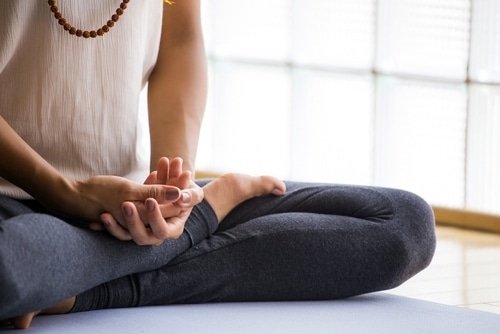By Joyce Willis, Therapist at The Meadows
Mindfulness is the innate ability to be fully present and aware of where we are and what we’re doing while not being overreactive or overwhelmed by what’s happening around us. Mindfulness meditation allows you to slow down racing thoughts, release negativity, and connect with your body and mind.
There are various mindfulness techniques, including sitting down for guided meditation or being more intentional about what you do each day. To get started, all you need is a comfortable place to sit, three to five minutes of free time, and a judgment-free mindset.
Benefits of Mindfulness Meditation
Practicing mindfulness meditation has physical and mental health benefits, including reducing stress, lowering your heart rate, improving immunity, and better sleep. Mindfulness-based stress reduction (MBSR) is a therapeutic approach to mindfulness meditation that reduces symptoms of stress and is beneficial for managing anxiety, depression, and chronic pain.
Heart disease is the leading cause of death in the United States, and mindfulness meditation has been found to significantly lower heart rates. Practicing mindfulness also improves your body’s resistance to illness by building immunity. Lastly, mindfulness meditation can improve sleep and be useful to treat various sleep disturbances. Although mindfulness meditation is a regular practice that can build stronger effects, it’s not necessary to do it every day. Practicing mindfulness three to four times per week can be significantly beneficial and regularly meditating for eight weeks can alter your brain.
Practicing Mindfulness
Mindfulness meditation is an effortless state of being. Some days can be more difficult to find when to meditate but plenty of everyday activities provide opportunities to practice mindfulness. These activities include brushing your teeth, washing dishes, doing laundry, driving, exercising, or getting your kids ready for bed.
Getting started with mindfulness meditation can be intimidating but finding ways to bring mindfulness into your everyday life will be beneficial to your overall wellbeing. Practicing these five key elements of mindfulness meditation will help regulate emotions, bring about positive changes in your mind and body, or simply help you reach a state of relaxation.
1. Don’t Get Caught Up on Expectations
Practicing mindfulness requires being aware of changes and noticing if and when they happen. Having certain expectations for your practice can actually limit your possibilities. Allow yourself to be fully present without preconceived notions of what your experience will entail.
2. Don’t Attempt to Be Mindful
Mindfulness meditation is best seen as spontaneous relaxation. Let yourself move into a state of being. If you try too hard to become mindful, you’re using your energy on the becoming instead of just being.
3. Accept Internal and External Distractions
To experience relaxation through mindfulness, you have to accept whatever is happening in each moment. Begin by accepting what is occurring externally in your environment—noises or sense movements—and accept whatever is happening internally in your mind. It’s natural that when we’re practicing mindfulness, we’ll have thoughts that pop up. Acknowledge those thoughts without judgment then return back to focus.
Also, notice and accept what’s happening inside your body. Do you have an itch or is your stomach growling? Gently acknowledge those feelings, release them, and return back to focus. Notice and recognize that no matter what’s happening in your environment, you can still focus. Oftentimes in meditation, we focus on the breath, but it can also involve focusing on sensations in specific parts of the body.
4. Allow Things to Flow
Awareness in the present is not a static thing. Each and every moment is unique. Things are constantly evolving. and in a state of flux. To be within this continuous flow, our awareness and our attention must be free to move and flow. Allow awareness to flow freely from one experience to the next in the present moment.
5. Be Cognizant of Your Awareness
Simply notice where your awareness is in each moment. In this experience, it’s impossible to not be present because I’m aware of whatever is before me. Every experience that we have can only happen if we’re present.
Practicing these five key elements of mindfulness meditation will help regulate emotions, bring about positive changes in your mind and body, or simply help you reach a state of relaxation.
Mindfulness Techniques at The Meadows
Mindfulness Meditation is an ancient practice that involves attending to the present moment with non-judgmental acceptance. While mindfulness can be practiced during meditation, it can be practiced in everyday situations to improve emotional, mental, and physical health. The Meadows incorporates mindfulness techniques and practices into many treatments, from lectures and practical exercises to its emphasis on meditation and yoga.
While it isn’t always called “mindfulness,” much of the therapeutic work at The Meadows serves to increase mindful awareness and acceptance of various bodily sensations, emotions, and thoughts that might have caused pain or suffering in the past.
The Meadows’ use of these holistic practices and ancient healing methods foster an open, curious and non-judgemental approach to life’s challenges, providing a key component to the trauma and addiction recovery process.
To learn more about The Meadows’ Mindfulness programs, call (866)-424-5476.



